DMI – Corso di laurea magistrale in Informatica
Copyleft
![]() 2016-2017 Giuseppe Scollo
2016-2017 Giuseppe Scollo
in questa esercitazione si trattano descrizioni in VHDL di componenti hardware di frequente impiego:
inoltre si propone un'esperienza di laboratorio in cui confluiscono diversi aspetti di VHDL illustrati dagli esempi qui presentati e alcuni componenti possono essere riusati per la realizzazione dell'esperimento proposto
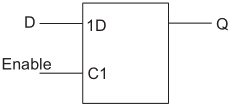
latch di tipo D
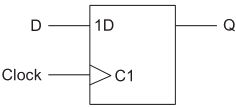
flip-flop di tipo D
library ieee;
use ieee.std_logic_1164.all;
entity latch is
port (
d : in std_logic;
en : in std_logic;
q : out std_logic
);
end entity latch;
architecture beh of latch is
begin
process (d, en) is
begin
if (en = ’1’) then
q <= d;
end if;
end process;
end architecture beh;
library ieee;
use ieee.std_logic_1164.all;
entity dff is
port (
d : in std_logic;
clk : in std_logic;
q : out std_logic
);
end entity dff;
architecture simple of dff is
begin
process (clk) is
begin
if rising_edge(clk) then
q <= d;
end if;
end process;
end architecture simple;
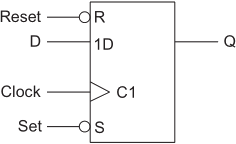
flip-flop di tipo D con set e reset asincroni
esercizio : correggere gli errori nel codice VHDL presentato nel testo di riferimento, p. 290
library ieee;
use ieee.std_logic_1164.all;
entity register is
generic ( n : natural := 8 );
port (
d : in std_logic_vector(n−1 downto 1);
clk : in std_logic;
nrst : in std_logic;
load : in std_logic;
q : out std_logic_vector(n−1 downto 1)
);
end entity register;
architecture beh of register is
begin
process (clk, nrst) is
begin
if (nrst = ’0’) then
q <= (others => ’0’);
elsif (rising_edge(clk) and (load = 1)) then
q <= d;
end if;
end process;
end architecture beh;
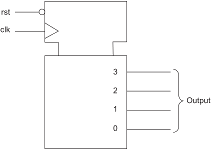
contatore binario
l'uso di variabili facilita la descrizione VHDL in stile comportamentale:
library ieee;
use ieee.std_logic_1164.all;
use ieee.numeric_std.all;
entity counter is
generic ( n : integer := 4 );
port (
clk : in std_logic;
rst : in std_logic;
output : out std_logic_vector((n−1) downto 0)
);
end;
architecture simple of counter is
begin
process(clk, rst)
variable count : unsigned((n−1) downto 0);
begin
if rst = ’0’ then
count := (others => ’0’);
elsif rising_edge(clk) then
count := count + 1;
end if;
output <= std_logic_vector(count);
end process;
end;
library ieee;
use ieee.std_logic_1164.all;
entity shift_register is
generic ( n : integer := 4 );
port (
clk : in std_logic;
rst : in std_logic;
din : in std_logic;
q : out std_logic_vector((n−1) downto 0)
);
end entity;
architecture simple of shift_register is
begin
process(clk, rst)
variable shift_reg : std_logic_vector((n−1) downto 0);
begin
if rst = ’0’ then
shift_reg := (others => ’0’);
elsif rising_edge(clk) then
shift_reg := shift_reg(n−2 downto 0) & din;
end if;
q <= shift_reg;
end process;
end architecture simple;
una ALU è una unità multifunzione: un input di controllo seleziona l'operazione da eseguire
| S | funzione |
| 00 | Q <= not A |
| 01 | Q <= A and B |
| 10 | Q <= A or B |
| 11 | Q <= A xor B |
library ieee;
use ieee.std_logic_1164.all;
entity alu_logic is
generic ( n : natural := 16 );
port (
a : in std_logic_vector((n−1) downto 0);
b : in std_logic_vector((n−1) downto 0);
s : in std_logic_vector(1 downto 0);
q : out std_logic_vector((n−1) downto 0)
);
end entity alu_logic;
architecture basic of alu_logic is
begin
case s is
when “00” => q <= not a;
when “01” => q <= a and b;
when “10” => q <= a or b;
when “11” => q <= a xor b;
end case;
end architecture basic;
le funzioni aritmetiche dell'ALU possono specificarsi in stile dataflow o, per operandi di più bit, in stile strutturale o comportamentale; quest'ultimo come segue
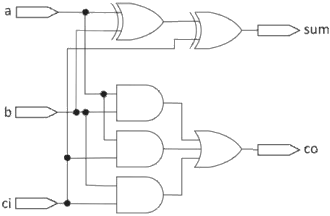
full-adder da 1 bit
library ieee;
use IEEE.std_logic_1164.all;
entity add_beh is
generic(top : natural := 15);
port (
a : in std_logic_vector (top downto 0);
b : in std_logic_vector (top downto 0);
cin : in std_logic;
sum : out std_logic_vector (top downto 0);
cout : out std_logic
);
end entity add_beh;
architecture behavior of add_beh is
begin
adder:
process(a,b,cin)
variable carry : std_logic;
variable tempsum : std_logic_vector(top downto 0);
begin
carry := cin;
for i in 0 to top loop
tempsum(i) := a(i) xor b(i) xor carry;
carry := (a(i) and b(i)) or (a(i) and carry) or (b(i) and carry);
end loop;
sum <= tempsum;
cout <= carry;
end process adder;
end architecture behavior;
probabilmente le unità funzionali combinatorie più diffuse nell'hardware digitale:
specifica VHDL generica del decodificatore (Zwolinski, sez. 4.2.3):
library ieee;
use ieee.std_logic_1164.all;
use ieee.numeric_std.all;
entity decoder is
generic (n : positive);
port (
a : in std_logic_vector(n-1 downto 0);
z : out std_logic_vector(2**n-1 downto 0)
);
end entity decoder;
architecture rotate of decoder is
constant z_out : bit_vector(2**n-1 downto 0) :=
(0 => '1', others => '0');
begin
z <= to_StdLogicVector (z_out sll
to_integer(unsigned(a)));
end architecture rotate;
specifica VHDL di un multiplatore a singolo input di selezione:
library ieee;
use ieee.std_logic_1164.all;
use ieee.numeric_std.all;
entity mux21 is
port (
s : in std_logic;
a : in std_logic;
b : in std_logic;
q : out std_logic
);
end;
architecture simple of mux21 is
begin
q <= a when s = ’0’ else
b when s = ’1’ else
’X’;
end;
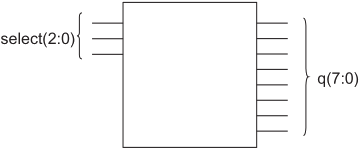
decodificatore 3-8
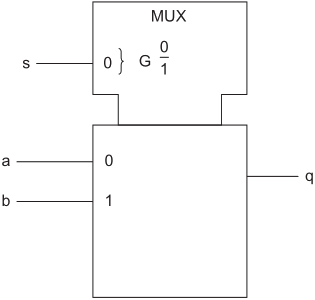
multiplatore a singolo input di selezione
dispositivo familiare di uso quotidiano ...
l'esempio che segue (tratto da Zwolinski, sez. 4.2.3)
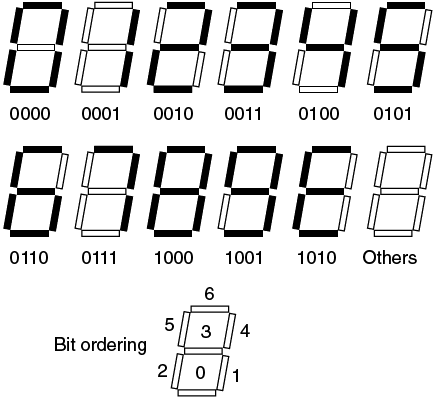
Zwolinski, Figure 4.3 - Seven-segment display
library ieee;
use ieee.std_logic_1164.all;
entity seven_seg is
port (a : in std_logic_vector(3 downto 0);
z : out std_logic_vector(6 downto 0));
end entity seven_seg;
architecture with_select of seven_seg is
begin
with a select
z <= "1110111" when "0000",
"0010010" when "0001",
"1011101" when "0010",
"1011011" when "0011",
"0111010" when "0100",
"1101011" when "0101",
"1101111" when "0110",
"1010010" when "0111",
"1111111" when "1000",
"1111011" when "1001",
"1101101" when
"1010"|"1011"|"1100"|"1101"|"1110"|"1111",
"0000000" when others;
end architecture with_select;
il simulatore di ALU a 8 bit realizzato da S. Lentini e G. Nicotra illustra come si possa costruire iterativamente l'ALU a 8 bit componendo opportunamente stadi di ALU a 1 bit
usando i costrutti VHDL visti negli esempi di questa esercitazione:
letture raccomandate:
letture per ulteriori approfondimenti:
materiali utili per l'esperienza di laboratorio proposta
(fonti: Biblioteca DMI, Altera University Program, 2014)